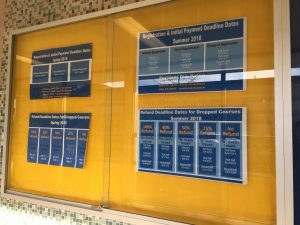NEIU’s retention numbers dropping
April 10, 2018
For every 100 students enrolled at NEIU, on average only between eight and ten counts toward NEIU’s overall retention and graduation rates.
Retention and graduation rates are data collected by all universities who receive federal funds and reported publicly in order to let prospective students know about their chances of succeeding at any university.
This data allows students to estimate how long it might take them to finish a particular degree at a university and potentially minimize their student loan debt. Retention and graduation rates are part of what dictates a university’s reputation and prestige for both current and potential students.
According to most recent census data, the higher level of a degree an individual has their median income increases. This data is correlated across race. The potential to earn more money is increased by earning a degree.
Retention is calculated based on students who are full-time and first-time freshmen. These are students who enroll in a university for the first time for 12 or more credit hours in their first semester and also return for the second semester. This group of students is tracked year to year to determine the graduation rate for the university. The federal government reports on the rate that these students graduate both in four and six years.
In 2016, there were 767 students who enrolled as first-time, full-time freshmen. There were 9,538 students enrolled at all levels at NEIU in that same year. In 2016, NEIU conferred 2,178 certificates and degrees.
The 767 freshmen students were 8.04 percent of the total student population.
The most recent year with federally complete graduation rate data was 2010. First-time, full-time freshmen students who enrolled in the 2010 class and graduated in four years (2014) or six years (2016) are counted toward NEIU’s federally reported graduation rate.
In 2010, there were 976 first-time, full-time freshmen enrolled. The total number of undergraduate students was 11,746. This percentage of students accounted for 8.31 percent or eight of every 100 students.
The percentage of students who returned was 64.1 percent. However, the percentage of those who graduated in six years was 23.9 percent.
In a statement to the Independent regarding NEIU’s retention and graduation rates, “The numbers you see on our website are federally mandated IPEDS data. It’s an old model and not Northeastern’s preferred method of measuring graduation rates. Our preferred graduation rate measure is the number of degrees conferred per 100 FTE (full-time equivalent) student enrollment.”
For example, if there are two students each taking two classes, together they would have the equivalent number of credit hours of one full-time student.
NEIU’s statement said, “It is calculated by the Delta Cost Project using IPEDS data. Degrees per 100 FTE student enrollment corrects for institutions who serve a large percentage of part-time and transfer students like Northeastern does.”
Using this model allows the university to provide a better picture of the impact it has as a whole. “Northeastern has set its frame of reference using urban peers, who have an average of 23.2 degrees per 100 FTE student enrollment. The Delta Measure for Northeastern has been higher than those of our urban peers, and have increased in the past three years. We also compare favorably with other Illinois public,” NEIU’s statement said.
The number of NEIU has risen from 25.6 in 2014 to 27.9 in 2016.
In the fall of 2017, Dr. Francisco X. Gaytán was appointed Provost’s Fellow for Student Success and Retention. He has been gathering and analyzing data alongside the NEIU Office for Institutional Research.
“Retention is important because as a minority when just one of us graduates from college we are the exception,” said Gaytán.
His work this past semester has focused on understanding the issues with NEIU’s retention and graduation rates. When asked why retention should matter to students who currently go to NEIU, Gaytán said, “You’re here to get an education. And students will say, ‘I’m here to make more money. I’m here to get a better job…’ Unfortunately, we’re not only stratified by education and by class in the U.S. but these things but these things overlap with race.”
In 2016 NEIU received a $2.8 million grant through the Developing Hispanic Serving Institution program through the Department of Education in order to assist with retention and graduation efforts related to Latino students at NEIU.
Gaytán’s research has focused on not only following the trends in the data at NEIU but also on ways that we can better utilize the resources we already have. He said one of his main goals is helping faculty understand the disconnect between upper division transfer students and incoming first-time freshmen and the needs of both groups of students.
He addressed the “myth” that NEIU does not have enough resources on campus. “We have a lot of services that we provide to our students. They’re just not very well coordinated (between each other) and sometimes the groups step on each others’ toes or bump into each other or give students inconsistent or conflicting information. Not intentionally, but it confuses students and makes it more difficult for them to find the help they need,” he said.
He also addresses that NEIU’s programs only serve a small number of students overall. Typically those who need the most attention and support.
He also addressed the idea that the successful programs that NEIU already has might not be able to accommodate more students in their programs. “Those success programs probably can serve a diverse group of students. If you only give them really hard to serve students, they’re not going to do well. But if you give them 120 students and half of them are in the pretty good academic shape they just need some of this cultural college-knowledge type information. I think that will be easy.
“But it might be a small percentage that needs intensive support. But as it is right now we don’t provide those upper level (entrance score) students any support other than ‘Here’s how you register for classes’. So I think we can bring it to scale. We can serve more students. As long as those students are more diverse in terms of their preparedness,” said Gaytán.
The example Gaytán used is El Centro, which admits students with both lower end and higher end entrance scores. They also have the highest retention and graduation rate among all the successful programs at NEIU. El Centro currently has a 53 percent retention rate for this year.
“We know what works. It’s just pulling the trigger. It’s saying ‘Let’s do this.’ It’s having the will to do it. The hard part is going to be organizing for change. The hard part is gonna be convincing people who are used to doing things one way to do something different. It’s not that its hard, It’s just different. It’s not that it’s complicated, It’s just not what we’ve been doing for a long time,” Gaytán said.
On April 5, students were invited to the “Black Student Consensus”. The purpose of the event was to better understand the experience of black students at NEIU from multiple perspectives.
Assistant Dean of Students Christopher Maxwell began the meeting with a prepared statement, “It is not enough to have individual stories to surmise what the black experience is like, but instead to gather a collected sense from the community overall. The office of student affairs wants this event to be the opportunity for you to not only better understand circumstances involving black students but to empower you all to voice and act on issues here at the place we all should call home.”
At the consensus meeting, students were encouraged to voice their opinions and concerns. Students brought up issues regarding student life, public-private partnerships on campus and retention rates among students of color. There weren’t many students in attendance but it was well received by the people there Students asked that the event happen more frequently to encourage more participation.
“I just want to see action behind it. There is no way we should still be facing the same problems. As one of the professors said since she was in grad school, ‘There’s no way we should be saying the same things.’ I also believe that we should stop having private entities come into the school and control things.
“There’s no way there should be a disconnect between The Nest and calling it NEIU’s Nest and that’s not the case.. There’s no reason students should feel a disconnect from their RA’s. They’re there for a reason, make sure that their school and campus life goes well.” Eric Winslow, a junior at NEIU, said.
“I would say about A’viands, there’s no way we can build a community and bring our own food in. We only get one day to do that and that’s international day. And that only happens once a semester. I believe if we had cookouts out in the quad that would help the students be more lively on campus,” he said.
Gaytán said, “I’ve heard many students say this, ‘I don’t want to be another statistic.’ ‘I don’t want to be just another black person without a degree.’ ‘I don’t want to be just another Latino that’s uneducated.’ It’s really important for me to be representative of my group.
“If you believe you’re a representative of your group and you’re concerned about the well-being of your group.. shouldn’t we also be concerned about the group? And the fact that the graduation rates from college are really low? We should actually be concerned about not just getting you out, not just getting one person out, we should be concerned about getting 1000 of us out. We should be concerned about increasing the graduation rates in general.”












Thomas Griffin • Apr 12, 2018 at 11:29 am
Casually observing the groups of students on tour during Freshman Orientation over the years, I see larger groups of Black students in the past five years. I often wonder how many of those students chose NEIU over Chicago State during the state budget impasse when CSU was on the verge of closing. The population who left Chicago State for whatever reason should be targeted by NEIU for recruitment with full acceptance of all CSU credits.
I agree with the student regarding the NEST and A’Viands. The no compete contract excludes culturally appropriate food of our communities unless we donate it to our events. Corporate industrialized approximations of our ethnic cuisines are simply cultural appropriations by an outsourced vendor.
I hope that the NEST will be more integrated into the main campus when it reverts to public NEIU control from the private sector American Campus Communities. Outsourcing is never effective, because, by nature the corporate interest only sees the university as another client, therefore it can never understand the collective culture of the university any better than the student and staff constituents of the university who have a real life stake in the game, besides a contract check.